Here is the final installment of the top thirty prospects. Unfortunately it is not an inspiring lot but prospect evaluation, and player development, is an uncertain process. With some luck the Jays top ten listed below will all develop well and be productive. That is what makes prospect following so enjoyable, you cannot predict the course of human histroy.
Number 30 through 21 are here. Numbers 20 through 11 are here.
Check back tomorrow for some words from Dick Scott, the Blue Jays farm director.
10. Tim Collins, LHP
Born August 29, 1989. Signed in 2007 (undrafted free agent).
| Year | Age | Level | G | GS | IP | H/9 | HR/9 | BB/9 | K/9 | ERA |
| 2007 |
18 |
A |
39 |
0 |
68.1 |
4.70 |
0.40 |
4.20 | 12.90 |
1.58 |
| 2009 |
19 |
A+ |
40 |
0 |
64.2 |
6.50 |
0.30 |
3.90 |
13.80 |
2.37 |
| 2009 |
19 |
AA |
9 |
0 |
12.2 |
8.50 |
0.70 |
5.00 |
12.10 | 5.68 |
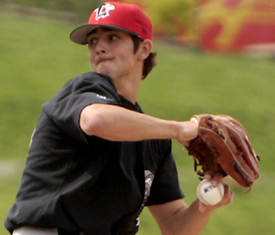
There isn't much to say about Collins that hasn't already been said. A favourite on Da Box, and a recipient of a fair bit of national media attention for a reliever, Collins has turned from a feel-good story to a legitimately exciting prospect over the course of the past season.
As absolutely everybody knows, Collins is small. Freakishly small for a potential major league pitcher. But that doesn't stop him from striking out a ridiculous amount of opponents. It was cute in Lansing. Then it just got weird in Dunedin. While Collins suffered through some growing pains (ha!) in New Hampshire, he continued to whiff more than 12 batters per nine innings with a 89-92 MPH fastball, a developing change, and a good 12-to-6 curve.
Collins's main weakness is, of course, the walks. He averages anwhere from four to five free passes per nine. But as of yet, that's truly his only weakness. And remember, Collins just turned twenty. This isn't some journeyman we're talking about. 2010 should see Collins head back to New Hampshire for the majority of the season. If he settles the walks down and continues to dominate opposing hitters, who knows, the Toronto bullpen could conceivably make a call.
9. Daniel Farquhar, RHP
Born February 17, 1987. Selected in the 10th round of the 2008 amateur draft.
| Year | Age | Level | G | GS | IP | H/9 | HR/9 | BB/9 | K/9 | ERA |
| 2008 |
21 |
A- |
12 |
0 |
26.1 |
6.84 |
0.34 |
2.05 |
9.23 |
2.39 |
| 2008 |
21 |
A |
3 |
0 |
6.0 |
0.00 |
0.00 |
3.00 |
6.00 |
0.00 |
| 2009 |
22 |
A+ |
17 |
0 |
17.0 |
5.29 |
0.00 |
5.82 |
12.18 |
0.53 |
| 2009 |
22 |
AA |
37 |
0 |
45.2 |
6.11 |
0.20 |
5.91 |
10.05 |
2.36 |
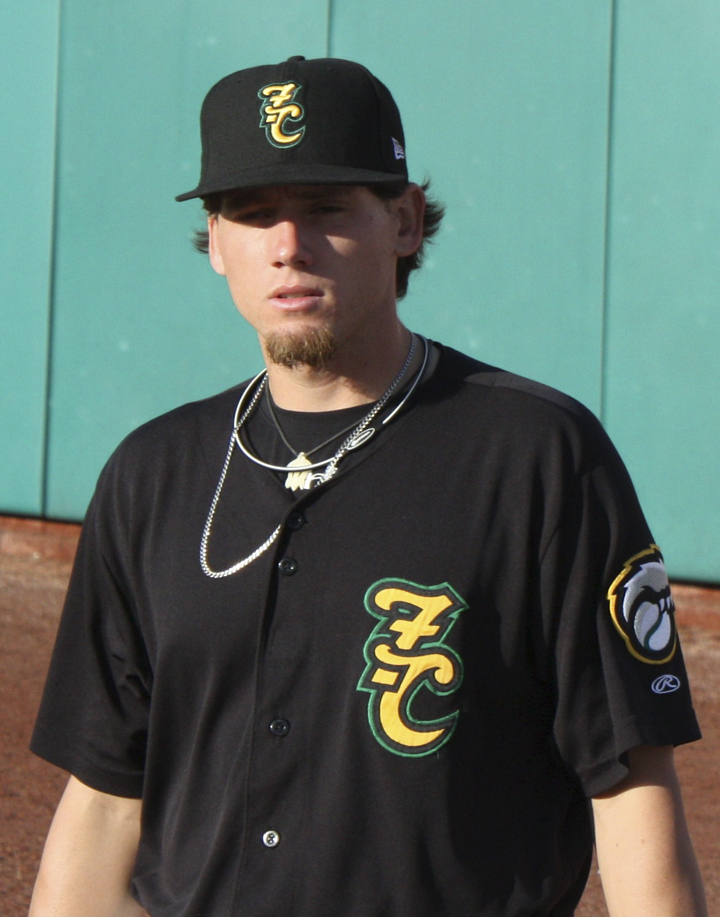
Only one Bauxite had Farquhar in their top 30 last year, which proves that even a blind squirrel will stumble upon a nut once in a while. However, this year all six members of the minor league crew had Farquhar in their top 30 as he followed a strong season in short season A ball with an impressive stint at Dunedin. That quickly led to a promotion and Farquhar had continued success at New Hampshire during the second half of the season.
There have been a lot of positive signs in Farquhar’s minor league performance so far. He’s only allowed one homer in each season and has held the opposition to below six hits per 9 innings. Farquhar induces grounders on about 50% of the balls in play and had an inflield fly percentage of 14.7%. Danny struck out over a batter an inning this year and maintained this strikeout rate after his promotion to New Hampshire. The only negative this year was that Farquhar struggled with his control at times and walked 41 batters in just over 60 innings. This was out of character for Farquhar, as going through his college stats he’s never been as wild as he was this year. Nevertheless, he proved you can still have success with a high walk rate if everything else is going well, but this will be a problem if he starts to concede more hits or doesn’t strike out as many batters.
Farquhar is an interesting pitcher as he’s a sidewinder who can throw from multiple angles. Danny throws side-armed in the high eighties to low nineties and has a plus slider that is reportedly very difficult to hit. He can also throw with a three-quarters delivery and over the top, where he reaches 95, and his ability to change arm angles keeps hitters off balance. While the usual caveats about minor league relievers apply, Farquhar has found success at every level and his control issues are the only red mark on his resume. Whether he starts in New Hampshire or not, he’ll likely be in Las Vegas by the second or third month of 2010 and very well could be in the majors by the end of the year.
8. Carlos Perez, CBorn October 27, 1990. Signed as a non-drafted amateur free agent in 2008.
| Year | Age | Level | AB | 2B | 3B | HR | BB | K | SB | CS | AVG | OBP | SLG |
| 2009 |
18 |
R |
141 |
11 |
3 |
1 |
16 |
23 |
2 |
5 |
.291 |
.364 |
.471 |
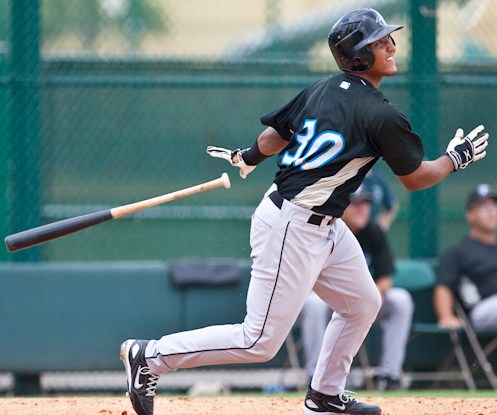
Only a year ago the catching position looked like an area of solid depth in the Toronto system. However, after fast-forwarding a year, some of the shine has come off of both J.P. Arencibia and Brian Jeroloman, the Top 2 catching prospects in the upper levels of the minor league system. Perez, though, offers some excitement for the future. Just 18 years old during the 2009 season, Perez settled into the North American style of baseball in just his first year since coming over from the Dominican Summer League (DSL).
Known for his advanced eye at the plate in the DSL (52 BBs, 28 Ks in 257 ABs in '08), Perez posted a walk rate of 10.2% in the Gulf Coast League. Overall, he had a line of .291/.364/.433 with 11 doubles in 141 at-bats. Perez also has good wheels for a catcher, although he was caught five times in seven steal attempts. Defensively, he is a solid catcher although - like most young backstops - he is still working on his game calling. He threw out 49% of base stealers attempting to run against him in '09 and 34% in '08.
7. Tyler Pastornicky, SS
Born December 13, 1989. Selected in the fifth round of the 2008 amateur draft.
| Year | Age | Level | AB | 2B | 3B | HR | BB | K | SB | CS | AVG | OBP | SLG |
| 2009 |
18 |
R |
160 |
6 |
3 |
1 |
21 |
21 |
27 |
5 |
.263 |
.349 |
.356 |
| 2009 |
19 |
A- |
413 |
11 |
9 |
1 |
39 |
50 |
51 |
15 |
.269 |
.336 |
.346 |
| 2009 |
19 |
A+ |
63 |
3 |
0 |
0 |
3 |
7 |
6 |
3 |
.270 |
.303 |
.317 |
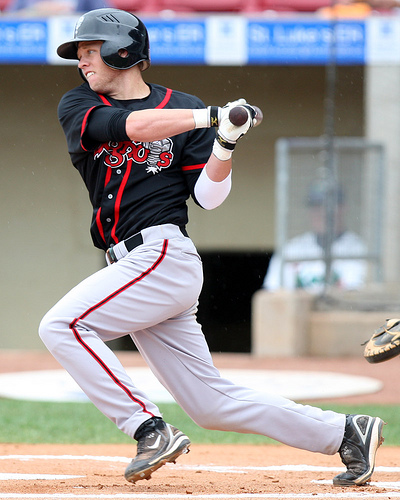
A fifth round draft pick out of a Florida high school who spurned Florida State University in 2008, Pastornicky was often overlooked in '08 despite respectable numbers in his debut. Challenged with a promotion to full-season ball in '09, the 19-year-old shortstop was one of the best players on the Lansing squad. Pastornicky hit .269/.336/.346 with 51 steals (66 attempts) in 413 at-bats before a late-season promotion to high-A Dunedin where he hit .270 in 63 at-bats.
He had a respectable walk rate in Lansing at 8.6% and a nice strikeout rate at 12.1%; Pastornicky looks to be a future No. 1 or 2 hitter. With an ISO of just .077 and a line-drive rate of 10.4%, the Florida native will certainly have to get stronger. His batting average has never been overly high, but he's consistently posted low BABIPs, including .304 in 2009. Pastornicky is a relatively steady fielder for his age but his range is average so he may have to move to second base down the road.
6. David Cooper, 1B
Born February 12, 1987. Selected in the 1st round of the 2008 amateur draft.
| Year | Age | Level | AB | 2B | 3B | HR | BB | K | SB | CS | AVG | OBP | SLG |
| 2008 |
21 |
A- |
85 |
10 |
1 |
2 |
10 |
16 |
0 |
1 |
.341 |
.411 |
.553 |
| 2008 |
21 |
A |
96 |
10 |
0 |
2 |
10 |
14 |
0 |
0 |
.354 |
.415 |
.521 |
| 2008 |
21 |
A+ |
92 |
9 |
0 |
1 |
10 |
16 |
0 |
0 |
.304 |
.373 |
.435 |
| 2009 |
22 |
AA |
473 |
32 |
0 |
10 |
59 |
92 |
0 |
0 |
.258 |
.340 |
.389 |
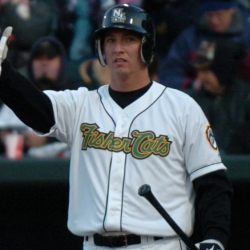
Expectations were high for David Cooper coming off an excellent debut season that saw him play at 3 different levels. Unfortunately, he didn't live up to those expectations, only putting up an OPS of .729 at AA, which is not the type of production you expect from a first-round first baseman.
It wasn't all bad, though. Cooper showed a good eye at the plate, with a not unacceptable 19.5% strikeout rate complimented by a very good 11.1% walk rate. Furthermore, his BABIP dropped from about .380 in 2008 to just .302 this year. Now, minor league data isn't detailed enough to determine where Cooper's true BABIP lies, but scouting reports have indicated that he's the type of player who can sustain a high BABIP (lots of line drives, gap power). If you adjust his 2009 numbers to match his BABIP from 2008, it would actually be somewhere between his production at Dunedin (.808 OPS) and Lansing (.936 OPS), assuming his batted ball profile hasn't changed much.
That's a lot of assumptions to make, though. Cooper may have been a little unlucky in '09, but in reality it probably didn't have a huge effect, and even if you adjust his numbers up a little, they're still disappointing. Given his reputation as a poor defensive first baseman, which is, as we all know, the easiest position to field, Cooper's bat needs to show some improvement this year if he is to be a major league regular.
5. JP Arencibia, C
Born January 5, 1986. Selected in the first round (21st) of the 2007 amateur draft.
| Year | Age | Level | AB | 2B | 3B | HR | BB | K | SB | CS | AVG | OBP | SLG |
| 2007 |
21 |
A- |
228 |
17 |
1 |
3 |
14 |
56 |
0 |
0 |
.254 |
.309 |
.377 |
| 2008 |
22 |
A+ |
248 |
22 |
0 |
13 |
11 |
46 |
0 |
0 |
.315 |
.344 |
.560 |
| 2008 |
22 |
AA |
262 |
14 |
0 |
14 |
7 |
55 |
0 | 0 | .282 |
.302 |
.496 |
| 2009 |
23 |
AAA |
466 |
32 |
1 |
21 |
26 |
114 |
0 |
1 |
.236 |
.284 |
.444 |
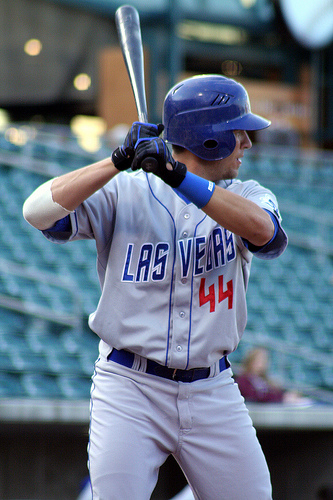
Arencibia's AAA struggles were well publicized. While he flashes a great deal of power, J.P. virtually refuses to reach base via any other method. Almost half of his 26 walks came during the month of May when he posted his only OBP above .300 (save for a .375 clip in 9 September games).
Like many power hitters, Arencibia is incredibly streaky. He went homerless in both April and June while smacking 8 each in May and August. He doesn't suffer from much of a home-road split with respective OPSs of .755 and .698, the difference made up from a 40 point swing in batting average.
Often a knock, Arencibia's defence has improved a great deal in AAA. After throwing out just 5 of his first 31 baserunners, Arencibia nailed 15 of the last 30 for an overall 33% kill rate.
While the Jays hoped to have Arencibia start the bulk of the 2010 season in Toronto, J.P. will need to repeat AAA while spending copious amounts of time on his plate discipline. The power is there and playing a premium position helps, but Arencibia still has a long way to go before showing he was worthy of a first round pick.
4. Chad Jenkins, RHP
Born December 22, 1987. Selected in the first round (20th overall) in the 2009 amateur draft.
| Year | Age | Level | G | GS | IP | H/9 | HR/9 | BB/9 | K/9 | ERA |
| 2007 |
19 |
NCAA |
17 |
4 |
40.1 |
10.0 |
0.9 |
4.5 |
9.8 |
4.02 |
| 2008 |
20 |
NCAA |
13 |
13 |
88.2 |
9.2 |
1.1 |
1.3 |
7.9 |
3.96 |
| 2009 |
21 |
NCAA |
13 |
13 |
92.0 |
7.8 |
0.3 |
1.5 |
9.6 |
2.54 |
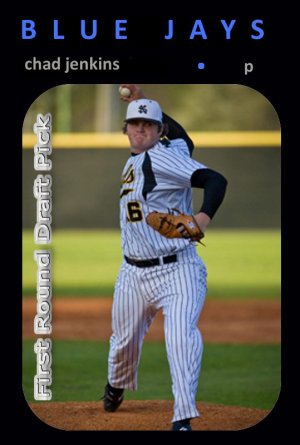
The Blue Jays were able to hammer out a deal with the Canton, Georgian native by signing the right-hander to a $1.359-million bonus just days before the August 17th deadline. It was the 12th highest bonus ever handed out by the Jays. He teamed up with Kyle Heckathorn (selected by Milwaukee 47th overall) to form a potent 1-2 duo for the Kennesaw State Owls. The Atlantic Sun Conference's Pitcher of the Year in 2009, Jenkins won eight of nine decisions with an ERA of 2.54 and had a streak of 41 scoreless innings and 24 2/3 innings without a walk. He pitched five complete games with two of them ending in shutouts. His only loss came against number 3 seeded Georgia Tech in which he only gave up two earned runs over six frames. In 92 innings, his K-BB total was an impressive 98-15.
Baseball America's Jim Callis says Jenkins has a tremendous feel for pitching with a fastball touching 96 MPH with a plus slider. His heater has been clocked in the 90-94 MPH range, his slider comes in at 83-85 MPH and his change registers anywhere from 82-85 MPH. The consensus about Jenkins is he could be a number two to four starter in a rotation but he needs to smooth out his delivery and mechanics. Fangraphs.com says Jenkins limited right-handed hitters to a .200 batting average but left-handed batters hit .287 off him and he'll need to improve his changeup to combat lefties. Still, he's been able to kill a lot of worms with a ground ball/fly ball ratio of 1.7 to 1. Jenkins has drawn praise for his smarts and his ability to make adjustments and be a workhorse on the mound. His build has drawn comparisons to Joe Blanton but his idols are Roy Halladay and Greg Maddux.
Where Jenkins will start his pro career has yet to be determined. The Jays could challenge him by putting him in Dunedin to start 2010 and hope he'll able to advance through the minor league ranks quickly.
3. Henderson Alvarez, RHP
Born: April 18, 1990. Signed as a non-drafted amateur free agent in 2006.
| Year | Age | Level | G | GS | IP | H/9 | HR/9 | BB/9 | K/9 | ERA |
| 2008 |
18 |
R |
12 |
11 |
46.1 |
12.20 |
0.58 |
1.17 |
6.60 |
5.63 |
| 2009 |
19 |
A- |
23 |
23 |
124.1 |
8.80 |
0.07 |
1.38 |
6.66 |
3.47 |
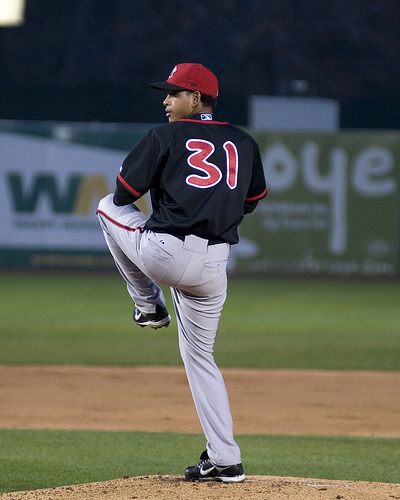
Alvarez was the jewel of the system in 2009, along with outfielder Moises Sierra and Zach Stewart, who was added to the system mid-season. The right-handed pitcher was in his second season in North America in 2009. Just 19 years old, the Venezuela native was the top pitcher on the Lansing staff. He allowed 121 hits in 124.1 innings of work, while posting a stunning walk rate of just 1.38 BB/9. He also allowed just one home run all year, thanks in part to a solid ground-ball rate of 51.4%.
Unlike a lot of ground-ball pitchers, Alvarez can actually get his fastball into the mid-90s. His two-seamer has excellent movement. He also utilizes a breaking ball and a good changeup. Although his fastball can touch the mid-90s, Alvarez does not strike out a ton of batters, as his strikeout rate was just 6.66 K%. That should improve with time, though, and he does a nice job of pitching to contact. If he can stay healthy, Alvarez has a high ceiling with his combination of control, ground-ball rate, and solid three-pitch repertoire. He should move up to Dunedin in 2010.
2. Moises Sierra, OF
Born September 24, 1988. Signed as a non-drafted free agent.
| Year | Age | Level | AB | 2B | 3B | HR | BB | K | SB | CS | AVG | OBP | SLG |
| 2006 |
17 |
DSL |
245 |
16 |
1 |
4 |
24 |
50 |
17 |
3 |
.253 |
.345 |
.376 |
| 2007 |
18 |
RK |
143 |
5 |
1 |
5 |
5 |
39 |
2 |
2 |
.203 |
.248 |
.357 |
| 2008 |
19 |
A |
451 |
16 |
5 |
9 |
26 |
114 |
12 |
11 |
.246 |
.297 |
.364 |
| 2009 |
20 |
A+ |
405 |
24 |
2 |
5 |
34 |
62 |
10 |
2 |
.286 |
.360 |
.393 |
| 2009 |
20 |
AA |
34 |
1 |
0 |
1 |
1 |
8 |
0 |
1 |
.353 |
.361 |
.471 |
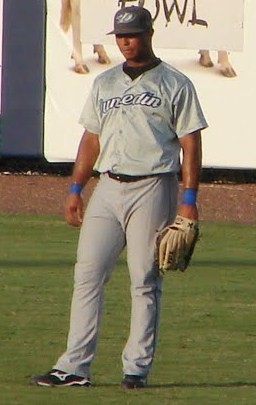
Another rapid riser, Moises Sierra improved his rating significantly this year after being rated 25th overall last year. A six-figure international signing Sierra had moved slowly but steadily through the lower rungs of the system until this season. He spent a year in the Dominican Summer League, a year in rookie ball and a year in Lansing, all the while trying to learn English and adjust to a foreign country.
The Jays sent Sierra to Dunedin this year where he had a strong year, even if his raw stats don’t stand out. Only 20, Sierra posted career highs in batting average, on-base percentage and slugging percentage. He made a big step forward in his contact abilities, as he struck out about half as often as he did last year despite playing in a higher level. This year Sierra hit noticeably better against left-handers than right-handers, which is something he’s done consistently throughout his career. So far he has not shown the power you want in a corner outfielder, but he is still young so that could develop in time.
Sierra is well known for possessing an outfield arm that is Barfieldeseque. It is easily the best arm in system and probably one of the best arms in the entire minors. Should he reach the majors, it’s likely you’ll see a lot of runners on first base plant themselves at second on any single to right. He had 15 assists between two levels this year, including two in six games at Double-A against runners who hadn’t read their scouting reports yet. Sierra made 9 errors this year, but it’s likely most of those were aggressive errors, so while that’s a high total it’s something that Sierra may carry with him wherever he goes.
After getting a taste of Double-A at the end of the season, Sierra will return to New Hampshire next year. He’ll likely spend the whole season at Double-A, as the Jays will take their time with the outfielder who will only be 21 during the 2010 season.
1. Zach Stewart, RHP
Born September 28, 1986. Selected in the third round of the 2008 draft.
| Year | Age | Level | G | GS | IP | H/9 | HR/9 | BB/9 | K/9 | ERA |
| 2008 |
21 |
A |
11 |
0 |
16.1 |
5.51 |
0.00 |
1.65 |
7.16 |
0.55 |
| 2008 |
21 |
A+ |
13 |
0 |
16.2 |
8.64 |
0.00 |
5.94 |
12.42 |
1.62 |
| 2009 | 22 |
A+ |
7 |
7 |
42.1 | 9.99 | 0.21 | 1.70 | 6.80 | 2.13 |
| 2009 | 22 | AA | 7 | 7 | 37.0 | 7.05 | 0.24 | 2.43 | 7.54 | 1.46 |
| 2009 |
22 |
AAA |
11 |
0 |
13.1 |
12.15 |
0.68 |
4.05 |
9.45 |
3.38 |
| 2009 |
22 |
AAA |
9 |
0 |
12.1 |
8.03 |
0.00 |
5.84 |
11.68 |
0.73 |
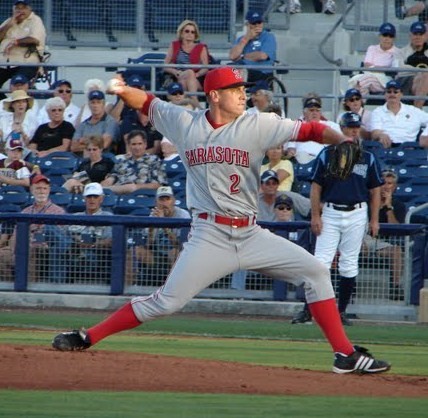
Zach Stewart, one of the newest Blue Jays, is our number one prospect. Stewart came to the Jays in the Scott Rolen trade and was considered the key part of the deal. Stewart was drafted in 2008 and has pitched less than one hundred and forty professional innings. Baseball America ranked Stewart as the Reds fifteenth prospect at the end of last season.
There are still some unanswered questions about Stewart such as what kind of pitcher is he and is he a starter or a reliever? If you look at the statistics for Stewart in the lines above you will see a pitcher who has given up a lot of hits and few hits, walked a lot and walked a little and struck-out lot and struck-out little. Stewart has pitched very little for most teams he has been on, forty-two innings at A+ is his longest stay, so his numbers are subject to small sample size biases. At AAA Stewart profiles as a high walk, high strikeout pitcher but at AA he was the opposite.
Stewart's strength is a hard running fastball that hitters find difficult to square up. Stewart also throws a slider and a change-up but both of those pitches need work. The Jays want Stewart to be a starter and that will require Stewart to improve the slider and change-up. Stewart will be limited to about 130 innings next season so he will probably split his time in 2010 between starting and relieving. Stewart has only 25 innings at AAA so he needs more time there to improve his pitches and to understand how to pitch to advanced hitters. Stewart could get some experience in 2010 as a major league reliever.
That completes our top 30 prospects for 2009. Check back tomorrow for an interview with Dick Scott.




